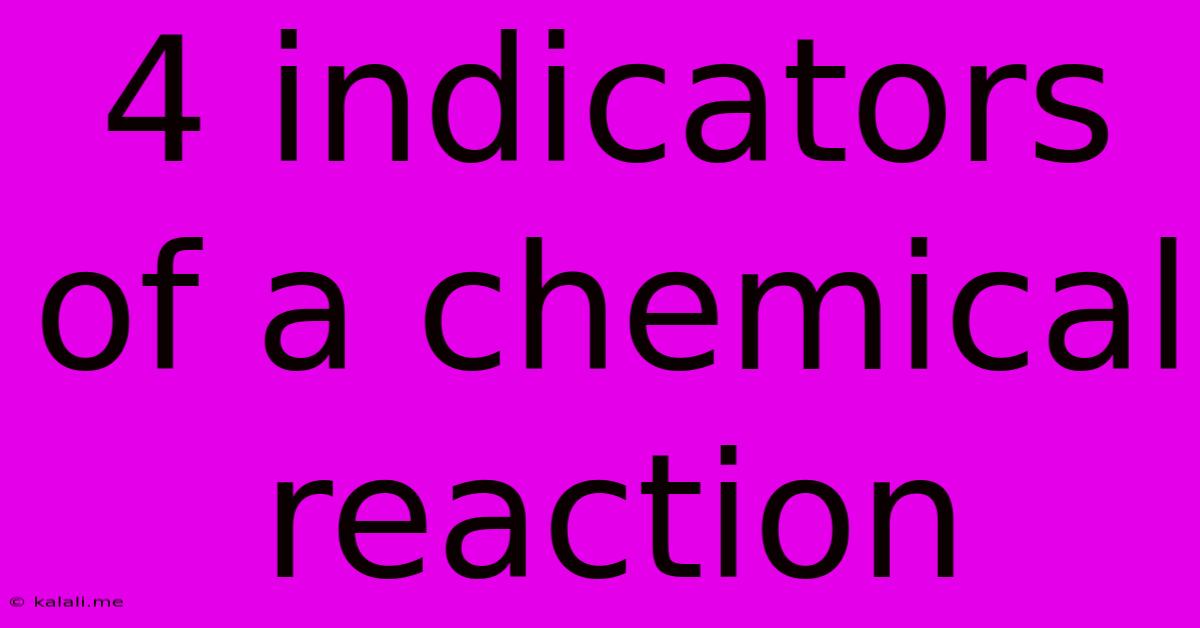4 Indicators Of A Chemical Reaction
Kalali
May 09, 2025 · 3 min read

Table of Contents
4 Indicators of a Chemical Reaction: A Comprehensive Guide
Meta Description: Learn to identify chemical reactions easily! This guide details four key indicators: temperature change, gas production, color change, and precipitate formation. Master these signs and understand the fascinating world of chemistry.
Chemical reactions are the fundamental building blocks of our world, transforming substances into entirely new ones. While complex chemical equations might seem daunting, identifying a chemical reaction is often surprisingly simple. By observing a few key indicators, you can confidently determine whether a chemical change has occurred. This article will delve into four common indicators that reliably signal a chemical reaction is taking place.
1. Temperature Change (Exothermic and Endothermic Reactions)
One of the most straightforward indicators of a chemical reaction is a change in temperature. Reactions that release heat are called exothermic reactions, while those that absorb heat are called endothermic reactions. Think about burning wood – a clear example of an exothermic reaction where heat is released, increasing the surrounding temperature. Conversely, dissolving certain salts in water can create an endothermic reaction, resulting in a decrease in temperature. Measuring the temperature change before and after the reaction using a thermometer provides a quantifiable indicator of a chemical transformation. This temperature change is a direct result of the breaking and forming of chemical bonds within the reacting substances.
2. Gas Production (Effervescence)
The production of gas is another strong indication of a chemical reaction. This is often observed as effervescence, the release of gas bubbles. This bubbling isn't simply the release of dissolved gases; it signifies the formation of a new gaseous product as a result of the chemical reaction. Baking soda and vinegar reacting to produce carbon dioxide gas is a classic example. The fizzing and bubbling you see is the visible evidence of gas production, a clear sign that a chemical change has taken place. Other examples include the decomposition of hydrogen peroxide, or the reaction between metals and acids. The type of gas produced can often be identified by its characteristic smell or other properties.
3. Color Change
A change in color often signifies that a chemical reaction has occurred. This occurs because the chemical structure of the reactants is altered, leading to a different absorption and reflection of light, resulting in a new color. The formation of rust on iron, where the reddish-brown iron oxide (Fe2O3) forms from metallic iron, is a classic example of a color change indicating a chemical reaction. Many chemical reactions involve the formation of colored compounds, making color change a simple and readily observable indicator. Note, however, that a color change alone might not always definitively confirm a chemical reaction; it's crucial to consider other indicators as well. The intensity of the color change can also be an indicator of the extent of the reaction.
4. Precipitate Formation
The formation of a precipitate is another definitive sign of a chemical reaction. A precipitate is a solid that forms from a solution during a chemical reaction. This solid is insoluble in the solution and separates out, often appearing as a cloudy substance or settling at the bottom of the container. For instance, when lead(II) nitrate solution reacts with potassium iodide solution, a yellow precipitate of lead(II) iodide is formed. This visible formation of a solid from a previously clear solution clearly indicates a chemical change. The nature of the precipitate—its color, texture, and solubility—can help identify the products of the reaction.
Conclusion:
While there are other subtle indicators, these four – temperature change, gas production, color change, and precipitate formation – are the most readily observable signs of a chemical reaction. By carefully observing these indicators, you can develop a keen understanding of the dynamic world of chemistry and the fascinating transformations occurring around you every day. Remember that multiple indicators appearing simultaneously provide stronger evidence of a chemical reaction. Learning to identify these signs enhances your appreciation for the fundamental processes shaping our world.
Latest Posts
Latest Posts
-
How Much Does A Full 15 Lb Propane Tank Weigh
Jul 15, 2025
-
Did Chester Wear A Brace On Gunsmoke
Jul 15, 2025
-
How Many Mikes Hard To Get Drunk
Jul 15, 2025
-
How Many Liters Has In Half Gallon
Jul 15, 2025
-
How Much Is Half Of A Mile
Jul 15, 2025
Related Post
Thank you for visiting our website which covers about 4 Indicators Of A Chemical Reaction . We hope the information provided has been useful to you. Feel free to contact us if you have any questions or need further assistance. See you next time and don't miss to bookmark.